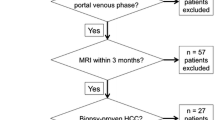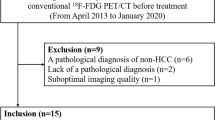Abstract
Objectives
To detect hypervascularized liver lesions, early dynamic (ED) 18F-FDG PET may be an alternative when contrast-enhanced (CE) imaging is infeasible. This retrospective pilot analysis compared contrast between such lesions and liver parenchyma, an important objective image quality variable, in ED PET versus CE CT.
Materials and methods
Twenty-eight hypervascularized liver lesions detected by CE CT [21 (75 %) hepatocellular carcinomas; mean (range) diameter 4.9 ± 3.5 (1–14) cm] in 20 patients were scanned with ED PET. Using regions of interest, maximum and mean lesional and parenchymal signals at baseline, arterial and venous phases were calculated for ED PET and CE CT.
Results
Lesional/parenchymal signal ratio was significantly higher (P < 0.005) with ED PET versus CE CT at the arterial phase and similar between the methods at the venous phase.
Conclusion
In liver imaging, ED PET generates greater lesional–parenchymal contrast during the arterial phase than does CE CT; these observations should be formally, prospectively evaluated.


Similar content being viewed by others
References
Bernstine H, Braun M, Yefremov N, Lamash Y, Carmi R, Stern D, Steinmetz A, Sosna J, Groshar D. FDG PET/CT early dynamic blood flow and late standardized uptake value determination in hepatocellular carcinoma. Radiology. 2011;260:503–10.
Chouillard EK, Gumbs AA, Cherqui D. Vascular clamping in liver surgery: physiology, indications and techniques. Ann Surg Innov Res. 2010;4:2.
Conover WJ. Practical nonparametric statistics. New York: Wiley; 1971.
Dill T. Contraindications to magnetic resonance imaging: non-invasive imaging. Heart. 2008;94:943–8.
Field AP, Miles J, Field Z. Discovering statistics using R. Thousand Oaks: Sage; 2012.
Freesmeyer M, Lopatta E, Schierz JH, Steenbeck J, Opfermann T, Settmacher U. Early dynamic PET imaging shows hypervascularization as exact as contrast-enhanced MR. Nuklearmedizin. 2012;51:N10–1.
Hohmann J, Skrok J, Basilico R, Jennett M, Muller A, Wolf KJ, Albrecht T. Characterisation of focal liver lesions with unenhanced and contrast enhanced low MI real time ultrasound: on-site unblinded versus off-site blinded reading. Eur J Radiol. 2012;81:e317–24.
Marin D, Nelson RC, Rubin GD, Schindera ST, Body CT. Technical advances for improving safety. AJR Am J Roentgenol. 2011;197:33–41.
Michelson AA. Studies in optics. Chicago: The University of Chicago Press; 1927.
Namasivayam S, Salman K, Mittal PK, Martin D, Small WC. Hypervascular hepatic focal lesions: spectrum of imaging features. Curr Probl Diagn Radiol. 2007;36:107–23.
Rhee CM, Bhan I, Alexander EK, Brunelli SM. Association between iodinated contrast media exposure and incident hyperthyroidism and hypothyroidism. Arch Intern Med. 2012;172:153–9.
Sandstede JJ, Tschammler A, Beer M, Vogelsang C, Wittenberg G, Hahn D. Optimization of automatic bolus tracking for timing of the arterial phase of helical liver CT. Eur Radiol. 2001;11:1396–400.
Schierz JH, Opfermann T, Steenbeck J, Lopatta E, Settmacher U, Stallmach A, Marlowe RJ, Freesmeyer M. Early dynamic 18F-FDG PET to detect hyperperfusion in hepatocellular carcinoma liver lesions. J Nucl Med. 2013;54:848–54.
Acknowledgements
We thank Robert Marlowe for editing the manuscript and Dominik Driesch (Biocontrol Jena GmbH, Jena, Germany) for performing statistical analyses. This research was funded from the regular University Hospital Jena budget.
Conflict of interest
None.
Author information
Authors and Affiliations
Corresponding author
Rights and permissions
About this article
Cite this article
Freesmeyer, M., Winkens, T. & Schierz, JH. Contrast between hypervascularized liver lesions and hepatic parenchyma: early dynamic PET versus contrast-enhanced CT. Ann Nucl Med 28, 664–668 (2014). https://doi.org/10.1007/s12149-014-0862-5
Received:
Accepted:
Published:
Issue Date:
DOI: https://doi.org/10.1007/s12149-014-0862-5




